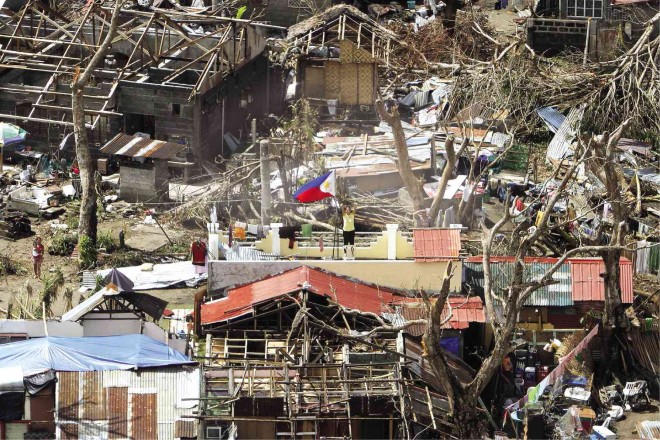City in ruins slowly picking up the pieces

HOPE AMID THE RUINS A woman waves from atop her destroyed home at the Inquirer aerial team, which surveyed the destruction caused by Supertyphoon “Yolanda” in Leyte on Saturday. Fluttering in the wind beside her is a Philippine flag. RAFFY LERMA
People in Tacloban City are slowly picking up the pieces of their shattered lives, with the city that only a week ago found itself in the eye of a monster storm trying to muster the courage to move on.
As litter and debris dominated the landscape of this storm-ravaged capital of Leyte province, pockets of the beaten city are beginning to come alive.
On Saturday morning—the usual market day in the provinces—a few ambulant vendors turned up at the break of dawn on Avenida Veteranos, selling what little they had salvaged from the rubble: vegetables, root crops, bananas and oranges, condiments, noodles, used or water-damaged clothes and toothpaste.
Small boxes for gift-wrapping shared space with picture frames, plastic bowls and glasses.
The smell of rotten food wafted from the piles of garbage as people quietly huddled around the precious commodities.
Article continues after this advertisementFellow feeling
Article continues after this advertisementNone of the sellers were heartless enough to want to rip off the cash-strapped survivors who were fellow typhoon victims.
Remy Yare, 34, was selling noodles for P50 a pack, which in better times would have sold for as high as P90 a pack, and a pack of “sotanghon” for P50 from the usual P60.
Yare said she decided to bring out her goods, lest they rot in her store that had been heavily damaged by Supertyphoon “Yolanda.”
Celia Orique, who is in her 60s, placed her goods—ripe squash and onions—on a piece of plywood she had picked up along the way. She said she had managed to secure the Davao-grown vegetables before Yolanda came.
Orique lost her house, but not everything.
“I only saved this shirt and shorts, but my husband and children are all safe,” said Orique, thanking the heavens for sparing her family from a greater calamity.
Greatest tragedy
The resilient attitude that Filipinos are known for is displayed in many houses across the city.
On Tacloban’s main streets and in many side roads, many children could be seen fetching water from busted water pipes, while their parents and elders cleaned their backyards that were strewn with every imaginable litter.
But for most of the city, recovery could take time as only the main roads are passable, having been cleared of debris by the public works department.
It will take years before the people of Tacloban and the surrounding towns can recover.
Malaysian Abdul Mutalif Abdul Rahim, an aid worker for some 20 years, said that Yolanda was “the greatest human tragedy” he had ever seen.
Ghost town
When the Inquirer team went around the city on Friday night—exactly a week after Yolanda ripped through this city, bringing winds and storm surges—the city that was once the commercial hub of Leyte and the whole of Eastern Visayas resembled a ghost town.
With power lines down, the city was in total darkness—only the public buildings serving as relief and rescue command centers such as the Leyte Sports Complex, City Hall and a few hospitals were lit up, courtesy of power generators.
Amid this massive humanitarian emergency, expecting survivors to find ways to move on at this point may be a pipe dream—many still had to find and/or bury their loved ones.
The Inquirer spotted yesterday one body still left lying by the roadside, but Interior Secretary Mar Roxas—after he was alerted by Social Welfare Secretary Dinky Soliman during a 7 a.m. briefing—had already made arrangements for its retrieval and transfer to one of the two mass graves at the outskirts of the city.
‘Anywhere but here’
Fleeing survivors said they were not just escaping the putrid smell of death, hunger and desperation.
They just wanted to forget.
Imelda Pasagui, 45, recounted the horror of a 5-meter storm surge that engulfed the coastal communities of the city on Nov. 8.
Pasagui and her family had heeded official warnings for preemptive evacuation, abandoning their house two days before Yolanda struck. They survived.
When she and her family returned to her barangay near Sto. Niño Church last Wednesday, Pasagui said bodies were still trapped under the rubble—in collapsed houses and structures, under the ships that had been washed ashore and in the many still inaccessible alleys and roads.
Pasagui was with her children, husband and a group of some 20 family members, neighbors and relatives who had camped out at the Tacloban port, waiting to be ferried by the Philippine Navy’s BRP Bacolod to Cebu.
She said she had relatives in Cebu City, but planned to reach Quezon City, or any place as far away as possible from their devastated hometown.
“Our houses were swept away. Nothing was left except the broken floors. There’s nothing here for us, nothing,” she said, fighting off tears.
“You can’t buy anything here,” she said. “(Take us) anywhere but here.”